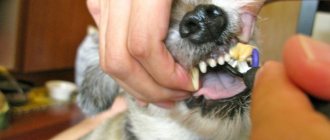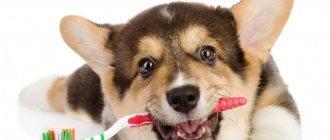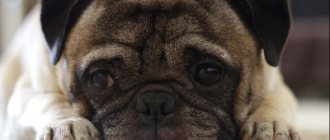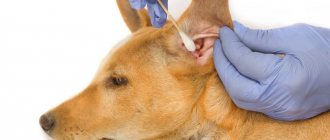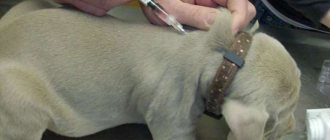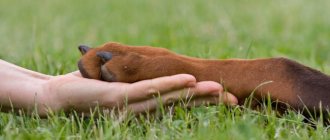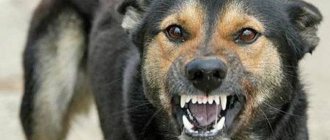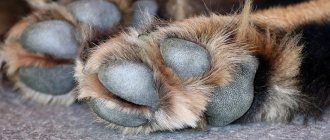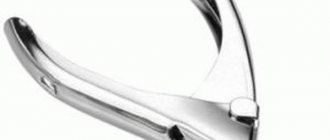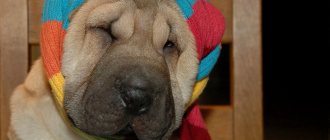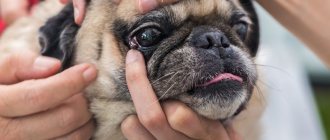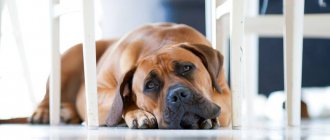Caring for your dog's oral cavity helps keep your four-legged friend's teeth strong and healthy for many years. The task of an attentive and caring owner is to conduct a systematic examination and cleaning of the pet’s fangs.
This hygiene procedure is performed as regularly as caring for the animal’s fur, ears, eyes and claws. You can conduct a dental session at home using simple devices and tools.
Necessity of the procedure
Caring for your pet's teeth is important not only for the pet's attractive appearance and eliminating unpleasant odor from the mouth. A dental procedure is necessary to prevent dangerous oral diseases. The most common problems include:
- caries;
- periodontal disease;
- stomatitis;
- gingivitis;
- abscesses.
If left untreated, pathologies become chronic and seriously affect the functioning of the entire body: from the cardiovascular system to general immunity.
Along with the lack of hygiene procedures, the condition of the canines is adversely affected by low-quality food. If there is not enough calcium and phosphorus in them, the enamel will become thinner.
There are breeds that are more prone to canine problems than others. These representatives include cocker spaniels, terriers and poodles. Dobermans, setters and sharpeis boast strong jaws.
Yorkie nail trimming
Long nails can damage a dog's paws by growing into them and scratching them, so nail trimming is a must. You need to trim your nails at least once a month. This is not an easy task; when starting it, be sure to be careful; it is very important not to cut the nail at the root, as this can hurt the nerves and injure your pet. Buy a special device - a nail clipper, which will greatly facilitate your work.
IMPORTANT! Don't forget to trim the hair on the sole of the paw, between the toes and on the pad, otherwise this hair will interfere with the dog's movement. If you find it difficult to carry out the procedure or do not have experience, it is better to trust the professionals.
Basic tools and tools
After accustoming the dog to the procedure of brushing teeth with gauze and broth, it will be necessary to purchase special tools and products. Just visit the nearest pet store or veterinary pharmacy.
Toothbrush or substitute
Brushes for cleaning a dog’s teeth vary in size and shape, but it won’t be difficult for the owner to choose the right model for his pet. The most comfortable are those that have natural and ultra-soft bristles. What types of brushes should you pay attention to:
- Double-sided
- a tool with a long handle that ends in bristles at both ends. On one side there are standard size bristles, on the other - smaller ones. Best suited for small breeds.
- Rubber
- a tool with silicone bristles that is placed on the index finger. This model is convenient to use for oral care of puppies and large breed dogs.
- Electric
– a brush powered by batteries or an accumulator. It produces ultrasonic vibrations, effectively removing plaque. The model is suitable for animals that do not experience fear of the procedure.
The choice of brush depends on the size of the pet, its age and the condition of its mouth. For example, comfortable models with soft bristles are not suitable for hardened plaque. In this case, purchase a tool with hard hairs.
Removing tartar from a dog
Tartar removal is possible only in a veterinary office or grooming salon by a qualified specialist. The procedure is carried out using special equipment and under “surgical” conditions.
Mechanical removal of tartar
Mechanical removal of tartar is carried out using dental instruments; the tartar is simply removed with a dental “spatula”.
Since tartar begins to form near the gums, this type of cleaning inevitably causes trauma to the gums themselves.
Tartar in a dog. Photo: enot.zp.ua
The procedure itself is outdated and harmful to teeth, because the protective enamel of the tooth is inevitably damaged. You should resort to it if there are contraindications to removing tartar using modern methods.
Ultrasonic cleaning of dog teeth
Ultrasonic dental cleaning is the most common method of removing tartar and is available in many veterinary clinics and grooming salons.
The essence of the method is to “destroy” the stone with an ultrasound nozzle and clean it from the teeth with a stream of water. The undoubted advantage of this method is the ability to clean each tooth from all sides and remove even huge conglomerates (tartar lying in a thick layer on the teeth). Unfortunately, in particularly advanced cases, injury to the gums is possible - if there is a stone that has “grown” under the gum, it will naturally be affected.
Laser teeth cleaning
This type of cleaning is just entering the veterinary services market. Finding a laser teeth cleaning specialist can be difficult, and the cost of the procedure is higher compared to ultrasonic cleaning.
The same dog after ultrasonic tartar removal. Photo: enot.zp.ua
The advantage of this method is less trauma: a special attachment with a laser more gently destroys tartar lying near the gums. But this is only possible if the teeth are slightly damaged by stone. Large conglomerates are in any case first destroyed mechanically or using ultrasound. After the stone is destroyed, its remains are also removed using a jet of water.
First cleaning
It is necessary to accustom your dog to brushing its teeth from puppyhood. However, adults also get used to this dental procedure. The main thing is to act patiently and without unpleasant pressure.
Preparing the animal
For real, using a brush and paste, the dog’s fangs should be treated after 6-7 months. Then the milk teeth are replaced with permanent ones, and they are the ones that require special care and attention. Before this, I use gauze and broth to get used to it (see below).
You should not perform manipulations on a full stomach, because a puppy or an adult dog may vomit. Veterinarians recommend starting in the evening, when the dog has walked, eaten and is ready to rest.
It is important to be persistent and not stop trying if you fail. If a puppy or adult dog does not resist and endures, then after a successful process you need to praise him properly.
How to teach a dog to brush its teeth step by step
During the first cleanings, it is important to remain calm for both the owner and the pet. You should not use violence or shout at the animal, so as not to develop a negative reflex at the sight of a brush and toothpaste.
With shy individuals you need to work very gently and affectionately, and with those prone to aggression or self-indulgence - strictly but kindly. It is important to show the dog that the procedure cannot be avoided - and there is nothing wrong with it.
As soon as the pet has become comfortable in your home, start touching its teeth - carefully touch the protruding fangs, and when the dog breathes with its mouth open, you can lightly touch the tongue. A little later, allow yourself to open your mouth with your hands. At the same time, do not cause discomfort to your pet.
Over time, the animal gets used to the fact that the owner can touch its mouth, tongue and gums. Then you can begin direct training.
For the first cleaning, it is best to proceed as follows:
- Prepare broth from lean meats or take your favorite pate.
- Wrap your finger in several layers of gauze or bandage.
- Dip your finger into the broth.
- Run it along the jaw: along the lips, near teeth, if the dog is calm - along the gums or tongue.
- Gradually, the intervention is made longer and the penetration deeper. At the end of the training, you need to reach the farthest molars with your finger.
Gradually, the broth is replaced with a special paste, and the gauze is replaced with a brush. The procedure of accustoming to new means and instruments also takes some time. Here you need to monitor your pet’s reaction and, if they do not accept them, choose others. Then the pet will not experience irritation and will quickly get used to the new sensations.
Introduction to brush and paste
After your four-legged friend has gotten used to cleaning his mouth with gauze moistened with broth, it’s time to introduce him to the brush and paste. They should be used after the animal is 6-8 months old. For a small dog, a small brush with soft bristles is suitable. Gradually the brush is replaced with harder analogues.
Each new brush should not be used immediately, but should be introduced to the dog first. Let the animal sniff the tool, touch it with its paw, or even bite it lightly. If things don't go well, you can soak the brush in the broth.
Before using the paste, you must show it to your pet. He must get used to the smell of the product. The dog can even taste it - this will make it easier to get used to and will simplify care in the future.
What can you use instead of pasta?
If you don’t have a special toothpaste on hand, you can use other products. Please note that you cannot use tooth powder or baking soda. Regular toothpaste is too aggressive for an animal, even for children.
For such purposes, you can use diluted hydrogen peroxide. Activated carbon, chlorhexidine, tomato paste. To do this, wrap the finger in a bandage, soak it in the product and clean the teeth.
Procedure algorithm
The procedure should be carried out within 2-3 minutes. A four-legged friend should not experience discomfort - only in this case will he be favorable towards this process. If the owner did not have time to treat the entire mouth, then it is better to do it next time or at least in a few hours.
There is a clear algorithm for how to brush your dog’s teeth at home. The action steps are as follows:
- Let the dog smell the toothpaste and brush. If he is well acquainted with these means, it is enough to simply show them to your pet.
- Lift your pet's lip and run your finger along the gums.
- Clean the outer side of the fangs first, gradually moving the brush in one direction. You need to move from the junction of the fang with the gum to its pointed end. You shouldn't press too hard.
- Press on the mouth so that the pet opens its mouth.
- Treat the inside.
Pets that eat dry food clean the plaque from the inside themselves, so this cleaning step can be skipped. After the successful completion of the process, you should encourage the pet, pet and praise it.
Dental injuries
Another danger is chips and breakages due to household injuries. It is not customary to treat dogs' teeth, so you need to take very careful care of your shaggy friend's mouth.
To preserve a complete “set” of teeth, it is important to remember the following rules:
- Don't let your dog chew or play with hard objects. Don't give bones. In the worst case, the pet will completely break the tooth, in the best, it will wear down and ruin the enamel.
- Don't play tug of war. The same goes for trying to tug on the leash. Ammunition is especially dangerous, since the carbine can become a kind of trap.
- Stay away from dogs in chains and parforces. A collision with metal can already cause injury, and if teeth accidentally get stuck in the links, then serious damage cannot be avoided.
- Do not let your pet hang from trees, tires or other objects. It is unusual for dogs to grasp and hold on with their teeth. In addition, your pet may be injured if it falls.
- Remove toys with plastic bottles. Give them only under supervision and very carefully. If your pet bites through the plastic, the sharp edge can damage the enamel and gums.
Do you want your dog to be healthy? Carry out regular self-examinations. An unpleasant odor and redness of the edges of the gums are alarming signs. Attempts to chew inedible things and lack of appetite in most cases indicate advanced inflammation. Your care and attentiveness are the key to success. Take care of your pets!
How often should you brush your dog's teeth?
Not all owners can independently and immediately determine how often they need to care for their dog’s teeth. Veterinarians recommend carrying out the procedure at least 2 times a week.
However, daily prevention of the formation of plaque and stone is optimal if the animal is prone to the appearance of such. This applies to breeds with a predisposition to dental disease and older pets.
You cannot refuse to treat the oral cavity if the dog is stubborn. You need to show patience and perseverance so that he begins to perceive the care procedure as a necessary ritual.
Diagnosis of dental plaque
Looking at the fangs and distant teeth, you can notice the stone even at an early stage of development. The beginning of the formation looks like a yellow plaque at the base of the tooth. This coating is soft and can be easily removed with a dog brush.
With irregular care for oral hygiene, plaque darkens, becomes hard and grows in volume.
Tartar itself does not threaten the life of the animal. But as it develops, bacteria enter the body and can cause serious illness.
Swollen and bleeding gums prevent the animal from eating. Due to the large number of bacteria, sepsis can develop. These consequences can be fatal.
The development of bleeding and sepsis can lead to death
Alternative options
If the animal flatly refuses to accept the procedure or is too aggressive, do not despair. The owner can always ask the veterinarian or veterinary pharmacy employee what else can be used to brush the dog’s teeth. Alternative options work well both as an addition and as a primary care product.
Gnawing toys
There is a real sea of toothpick toys in pet stores and online stores. These oral appliances are made from edible or inedible materials that are safe for the health of the animal.
Their use helps eliminate plaque and keeps the oral cavity in good condition. This is especially important for breeds that participate in hunting and must have strong, strong jaws.
Special dice
Four-legged friends love to chew bones. Natural raw bones are suitable as an alternative to synthetic bones. The main thing is not to give tubular bones, which can harm your pet.
Special sticks and bones are not only effective for removing plaque, but also beneficial for the animal’s body. Manufacturers enrich their composition with vitamin and mineral supplements that have a good effect on the condition of the mouth and gastrointestinal tract.
Chewable treats
Chewable treats have the same effect as bones. They consist of ingredients that strengthen the dog's chewing muscles and help cleanse the mouth.
When choosing treats to chew, you need to pay attention to their composition. They must not contain artificial flavors or synthetic flavorings. An excellent option would be dried tripe or other dried/dried offal.
Dry food
Feeding dry granules is a good prevention of stone and plaque formation. It has been proven that the introduction of this type of food into the diet speeds up the cleaning of the oral cavity by 2-3 times.
A high-quality dry product is enriched with vitamins and minerals, which have an additional positive effect on the condition of the enamel.
Additives to water
To prevent the appearance of plaque and stone, you can use special additives in water. They are produced in the form of gels, solutions or tablets. Purchase supplements from a veterinary pharmacy and use them only strictly according to the instructions. Thanks to these products, the dog freshens his breath and cleanses the surface of the enamel from plaque.
Prevention of diseases.
The narrow mouth and closely spaced teeth of the Yorkshire Terrier mean that food particles often get stuck in the mouth, causing plaque and bad breath. This happens due to the lack of hard, “abrasive” food in the dog’s diet.
Preventative measures include:
- Adding foods to your diet to help get rid of stuck food pieces, such as chewy biscuits or seeds. Crackers or apples and hard carrots are also suitable for these purposes.
- Including tomato juice in food. Veterinarians recommend it as a good plaque cleaner. You can add finely chopped tomatoes to your food; Yorkies eat them with pleasure.
Visiting a veterinarian-dentist
Regular examination by a veterinarian is important for a pet of any age. If the doctor sees that the patient’s oral cavity is in poor condition, then a visit to the dentist is inevitable.
Is a routine inspection necessary?
A routine examination by a veterinarian is necessary for animals of all ages. It is often combined with vaccination.
The doctor examines the patient, takes his temperature, and also looks into his mouth. If there are any suspicious spots, plaque, or inflammation, the owner and the animal are sent to a specialist. A routine examination by a therapist is carried out annually, for elderly pets and chronically ill animals - 2-3 times a year.
The intervention of a veterinarian-dentist is necessary if the owner cannot cope with the care of the pet’s fangs on his own. This happens when the food is selected incorrectly or when soft food predominates in the diet. A visit to the dentist is necessary if the owner notices:
- bleeding or reddened gums;
- unpleasant odor from the mouth;
- dark spots on the enamel.
The dentist will examine the patient and give recommendations on mouth care. The doctor may prescribe a special medicinal paste or vitamin complexes that will have a positive effect on the animal’s condition.
Briefly about Yorkies
In the past, merciless hunters of rodents and other pests, Yoricks are now considered an aristocratic breed. They were bred in the English counties of Yorkshire and Lancashire, where the name of the breed came from. The silky coat is one of the most noticeable external features of the Yorshik. And, of course, it will require careful care from the owner. One of the main advantages of these fluffies is that they do not shed.
Yorkshire Terriers are known for their energy and courage. At the same time, they always remain intelligent, and even sometimes stubborn.
This dog is suitable for an apartment and can be easily toilet trained. She will feel comfortable even in a small room. And caring for her is easy and pleasant.
The lifespan of Yorkies ranges from 12 to 15 years.
